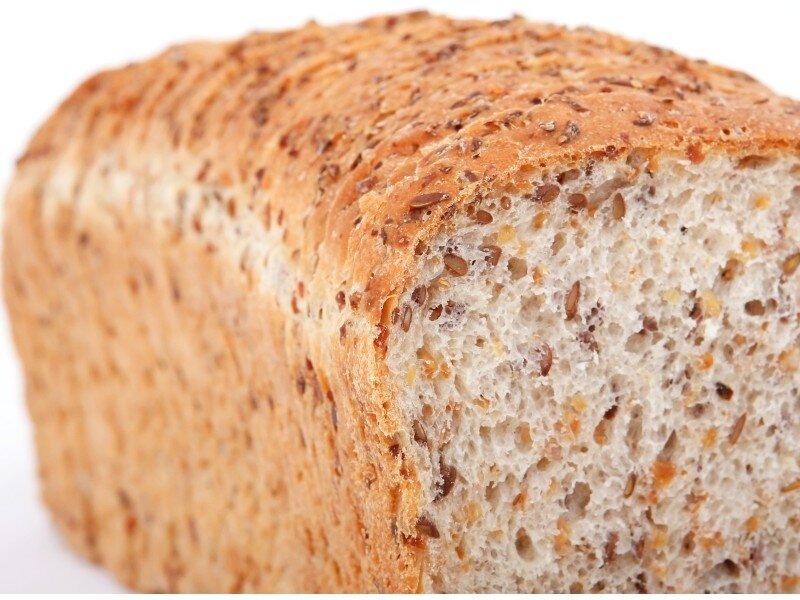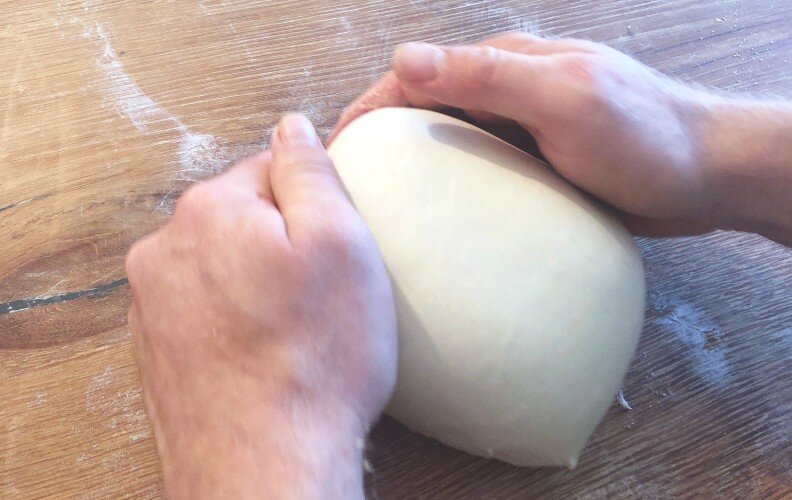what causes bread to fall in the middle
As a bread baker, you want to brand sure that all your hard piece of work is worth it. If you're not aware of all the pitfalls, breadstuff can hands collapse or shrink after information technology'southward baked. These defects can be a negligible slight dimple to a giant crater! Either fashion, if there's a way to avert it, you'll want to know how to forbid your bread collapsing or shrinking! Then why does this happen? Well, offset let'south wait at the overlying reasons for bread to collapse:
Breadstuff collapses after baking due to moisture remaining in the nibble. Equally bread cools, moisture escapes causing the breadstuff to shrink. As it is released from the crumb, water latches onto the crust, making it heavier. The chaff is pulled downwardly past gravity and if the crumb structure isn't strong, the crumb contracts. This leads to the crust collapsing or wrinkle lines appearing on the surface.

In that location are several reasons this could happen. The crusade could be down to one single consequence, but most likely it'll be a combination of small faults. Fixing collapsing bread may accept a handful of examination batches. Wait to exist patient and go on tweaking, fifty-fifty if yous don't succeed at first!
The 7 Things You lot're (Probably) Doing Wrong!
Ameliorate Your Baking Skills With My Free Email Course- Sign Up Here!
Hey there! Some links on this folio are chapter links which means that, if you choose to make a purchase, I may earn a pocket-sized commission at no actress price to you. I greatly appreciate your back up and I hope you enjoy the article!
Causes of bread collapsing after blistering
In that location are seven things you should consider when fixing bread that is collapsing later baking. Cooling and shaping are of import for any type of staff of life. But, depending on the bread existence made there are two main avenues to focus on.
For quickly made bread, a low hydrated dough, plenty of kneading and a high poly peptide flour is important.
For longer proofed artisan bread, give the dough enough of time to ferment and master the blistering temperature and duration.
Let's look at these solutions in more than item. We'll cover the reason for wrinkles in the chaff afterwards every bit they are semi-related.
#1 Reduce the h2o in the recipe
A strong gluten network is reliant on well-hydrated flour. If a dough has too much moisture, it can crusade the nibble to contract every bit information technology cools. Rapidly made loaves more often than not prefer dryer doughs to avoid shrinkage. If your dough is also wet, lower the corporeality of water in the recipe next time. Baking for a trivial longer can also help solve the problem.
#ii Bake for longer
To make a dough structure less moist in an open crumb structure instead of lowering the hydration of the dough, bake it for longer. Use my guide on the ideal oven temperature for bread to see the perfect solution. A loaf with a crisp, set crust is more resistant to caving in as it cools.
#iii Extend the fermentation fourth dimension
An artisan loaf needs plenty of time for water to soak the gluten. Awarding the dough more time to balance or adding an autolyse footstep allows it the gluten to. There will also be benefits from the increased amounts of organic acids and ethanol found in extended fermentation. This will strengthen the gluten and make the staff of life less resistant to collapse.
#iv Reduce the yeast/ more kneading
Bread tin collapse if at that place is also much gas in a dough that is not mature enough. A weak gluten construction can create large irregular pockets of air through the crumb, sometimes called tunnelling. These are oftentimes establish most the crust area which tin can cause the crust to sink as it cools. Reduce the amount of yeast used and increase the rising time, or knead for longer to set the trouble.
#5 Switch the flour
A weak chaff causes bread to collapse. A common dilemma when commercially baking is when a new batch of flour arrives. The new flour makes the dough behave differently and can lead to more than shrinkage or the staff of life collapsing. The type of flour used is as well a key contributor to the chewiness of a loaf.
A strong crust comes from a well-developed dough. To accomplish this, a flour with high-quality gluten which is well kneaded is essential. Sometimes lowering the water in the recipe can prevent recurrences. Otherwise, adding a little vital gluten pulverization or changing to a high protein bread flour can fix the problem.
#six Piece of work on your shaping

To control the rise of bread, shaping has a major impact. Stretching the outer membrane to create tension volition help a lot. This provides back up for the dough as it rises. Poor shaping is specially prevalent in bread machines. Here, the breadstuff oft collapses as the dough is non shaped. To find out more than nigh shaping, see my shaping and preshaping guide.
#7 The importance of cooling
As the bread cools information technology needs to expel moisture from the nibble. It's an important step in blistering that is oftentimes not taken as seriously as it should. Wet clings onto the starch particles on the outside edges of the crust as information technology exits the core of the cooling bread. This allows the starch to harden and burst which contributes to making the crusty crispy.
If the bread tin can't escape from the edges considering say, the staff of life remains in the tin can after blistering, or cooling loaves are lined up next to each other, we will have a problem!
Equally moisture can't escape from the sides, it tries to force itself up through the weakest points on the height of the bread. This creates irregular patches of wet which can atomic number 82 to random craters on the surface of the staff of life or the loaf collapsing.
Why does my bread wrinkle on the surface?
It's common to see bread, specially soft rolls wrinkling once absurd. All bread shrinks as it cools, just it's more noticeable in soft types of bread. Soft staff of life contains more than moisture, then as it cools the crust absorbs lots of water. This weighs down the crust which collapses as the staff of life shrinks to create wrinkles. They are not easy to prevent.
To make soft and fluffy bread, we apply high amounts of yeast alongside fast mixing. These accelerate the proofing time and retain moisture in the crumb. They are baked quickly, again to keep a moist crumb. The consequence of wrinkling occurs afterward blistering when the rigid gluten structure allows wet to escape upwardly. The crust absorbs some of the escaping h2o and as its weight increases, information technology contracts. This pulls the crust down and reveals wrinkles on the surface.
How to finish my soft rolls from wrinkling after baking?
The all-time solution to prevent wrinkle lines on your bread is to requite the tray a hard bang on the table equally they leave the oven. This sets the crumb and prevents wrinkles from appearing. Yous can as well try using high protein flour or baking for a longer time.
Should I encompass the bread with a towel?
Covering the bread with a tea towel or similar during cooling is a popular way of softening bread. It works well for this purpose, just if yous are finding wrinkles on the surface y'all might prefer to let the breadstuff cool for a flake earlier adding the tea towel.
Other causes of wrinkles include high humidity, high proofing temperature, too much fatty, too much sugar or over-proofing.
Why do my cinnamon rolls shrink after baking?
The near common reason for shrinkage is that the dough was chilled before shaping. This will crusade the butter to be besides common cold and stiff, which can lead to a denser dough that doesn't rise as well. Make sure your buns are at room temperature when you shape them so they don't get too dense or tight.
Another possible culprit is over-kneading the dough. This could produce an rubberband dough that'southward more suitable for bread. Firm doughs contract more equally they cool so you will cease up with shrinking buns. Try and aim for a light and fluffy cake batter texture when you brand cinnamon buns.
No-knead bread collapses after baking?
This is probable due to a lack of gluten development as the dough was not kneaded. To forbid this from occurring, place the dough in the fridge overnight. This will let the gluten to develop in a compact network that doesn't plummet after baking.
Why does baked bread sink in the middle?
If in that location is likewise much moisture in the bread later on baking, or the staff of life is underbaked in the middle, it may collapse as it cools. Bake for longer, lowering the temperature of the oven if the crust browns before the eye is cooked through.
Source: https://www.busbysbakery.com/bread-collapsing-or-shrinking/
0 Response to "what causes bread to fall in the middle"
Post a Comment